Inline skate wheels: Will the diameter race ever stop?
The following article is constantly evolving. The market of speed skating wheels is one of the rare markets to be in perpetual motion. In less than 20 years, the wheel diameter has grown from 76 mm to 110 mm and it seems that the race is not over...
Par alfathor
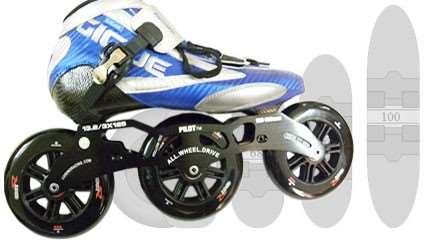
The history of the evolution of wheel diameter
 It is not the beginnings of big wheels. In Rollermania, Sam Nieswizski (1991) tells us that the cycle skates of the early 19th C. already used tires close to those of small bicycles. In 1997, Rollerblade’s all-terrain Coyotes already had 160 mm wheels.
It is not the beginnings of big wheels. In Rollermania, Sam Nieswizski (1991) tells us that the cycle skates of the early 19th C. already used tires close to those of small bicycles. In 1997, Rollerblade’s all-terrain Coyotes already had 160 mm wheels.
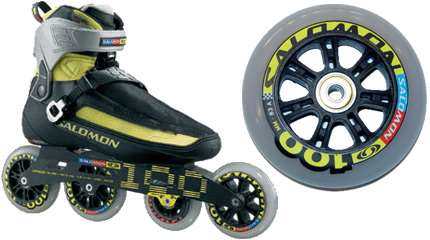 Yet, the great diameter boom for skating wheels started in the 90’s with the development of inline skating, particularly on the speed skating market which is a technological niche in perpetual motion.
Yet, the great diameter boom for skating wheels started in the 90’s with the development of inline skating, particularly on the speed skating market which is a technological niche in perpetual motion.
Progressive appearance of:
- the 76 mm (early 90’s)
- the 80 mm (mid-90’s)
- the 84 mm (late 90’s)
- the 100 mm (2003-
- the 88 mm (2004/2005)
- the 90 mm (2002/2003)
- the 110 mm (2006/2007)
- and soon the 125 mm ? (prototypes in 2003, 2007 and soon to come in 2014)
What is hiding behind such a variety of wheel diameters? A quest for the best compromise? A marketing strategy from the brands to give fresh boosts to an asphyxiated market? Or is it simply a phase of technological transition?
So many causes are intermingled that the answer is hard to find.
Advantages and drawbacks
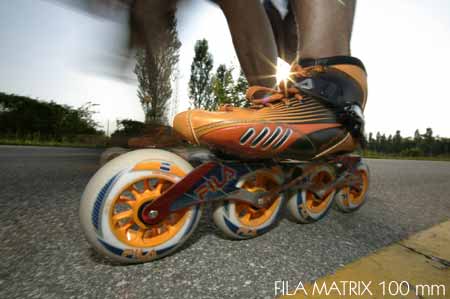 Today with hindsight, we realize that the diameter increase of wheels had positive effects on the whole, improving the times as well as the comfort of skaters on damaged grounds.
Today with hindsight, we realize that the diameter increase of wheels had positive effects on the whole, improving the times as well as the comfort of skaters on damaged grounds.
Let’s also note that other changes are more dubious: the bigger the diameter, the more demanding on the skaters’ ankles, which increases the risks of injuries. A good skating technique has become essential to be able to skate with big diameters, just as a finer adjustment of the equipment is needed, even if the equipment has adapted to the increase of wheel diameter. Women took more time than men to start skating with 4x110m set-ups.
According to us, the regular increase of diameter is inevitable. On the one hand because we are always looking for more performances, and on the other hand because human morphology evolves from one generation to the other: the average European man has gained 11 cm in one century, i.e. 1 cm per decade! The supplementary physiological constraints are then (probably) partly compensated by the improvement of the skaters’ physical abilities.
Back into the past: the arrival of the 84 mm wheels
According to Christophe Audoire, with a 11 mps speed (about 40 kph), the 84 mm enabled to gain 40 cm on 10 m, that is to say 2 to 3 minutes on a marathon. Indeed, a consequent gain in performance on various races could be noticed at the time. However one could not reasonably credit all those improvements to the development of the equipment. Training techniques also evolve. Today, the average speeds on marathons regularly exceed 41 kph (on some routes).
2003: the shift to 100 mm wheels
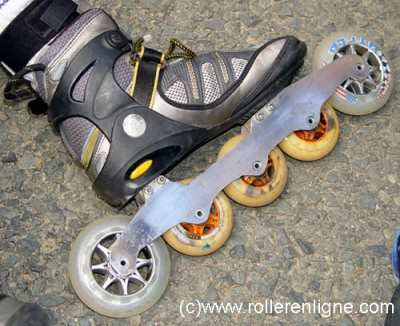 From 5×84 mm wheels, the market evolved towards frames with 4 wheels of 100 mm. Some set-ups even offered 3×100 mm + 1×90 mm or 1×84 mm diameters.
From 5×84 mm wheels, the market evolved towards frames with 4 wheels of 100 mm. Some set-ups even offered 3×100 mm + 1×90 mm or 1×84 mm diameters.
The CIC and FIRS international rulesets limit the length of a frame to 50cm including the wheels. At the time, the maximum size of wheels was not stated in the rules. The transition to the 100 mm happened smoothly.
Just like any innovation, a period of adaptation was needed. The center of gravity is higher, the inertia of the skater is greater, the skating is thus unavoidably altered. A few millimeter change has an impact on the whole balance of your body.
100 mm wheels were quickly adopted by Arnaud Gicquel and Kalon Dobbin. They had interesting results on damaged grounds and on track. Some then would say that Arnaud Gicquel could win anything, whatever the equipment he would skate with. Some prototypes with 125 mm wheels were spotted on American websites, but height issues tended to put a damper to the most audacious skaters. Skating is easier when your center of gravity is not raised too high.
According to Andy Lundstrom of Xenan, three 100 mm wheels out of four is enough to feel the difference, especially for the ability it gives to cope with damaged grounds. Moreover, your balance is improved due to the increase of the gyroscopic effect.
The progressive increase of wheel diameter reduced friction with the ground a lot. The greater inertia enables to keep a high speed longer with less effort, the perfect panacea for long distance skating. With the same stride, you cover more distance. The 100 mm helps compensate for the defects of our roads: a high diameter softens the damaged parts dreaded by all skaters.
With the increase of speed, the air resistance increases too. For a 5% speed gain, the air resistance increases by 10%. It means that the skater has to exert more and more energy to go faster and faster. This is when skating in the stream of another skater takes on its full meaning. Pack work enables to reduce that drawback. The problem of starting the skates still remains. They are efficient only once they are set in motion. As for hill climbing, the weight increase of the frame and wheels may prove to be tricky. You can frequently witness good long distance fitness skaters negotiating their ascents better.
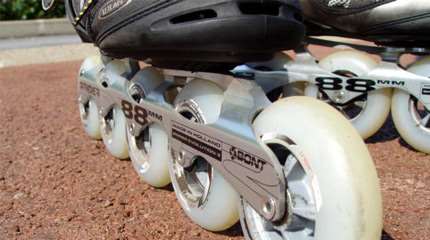 100 mm skaters often meet more difficulty struggling alone against the wind and they quickly have the feeling of hovering.
100 mm skaters often meet more difficulty struggling alone against the wind and they quickly have the feeling of hovering.
Transitioning towards 100 mm set-ups also caused a change of axle spacing. the 165 mm progressively made room for the 195 mm which enables to limit the raising of the boot and thus of the center of gravity. A good opportunity for brands to reboot the market of skating in its whole! Axle spacing change = boot, frame, wheel change. QED.
A brief episode: the 88 and 90 mm
The 100 mm imposed itself so quickly that we almost forgot that its arrival on the market coincided with that of alternative concepts: 5×88 mm and 5×90 mm frames. For several months, packs with various configurations mixing 4×100 and 5×90 mm could be observed on races. But the 5×90 mm didn’t resist to the 100 mm tidal wave. However that set-up is sometimes used for downhill competitions with technical rolling routes.
The 5x88mm frames were produced by Bont. Let’s specially mention the Bont Snipers equipped with Cragar wheels.
In France, Diabolik also released 5×90 mm models. Tristan Loy was one of the most tenacious skaters. That equipment is very demanding to be set in motion.
2006-2007: Legalize my 110 mm!
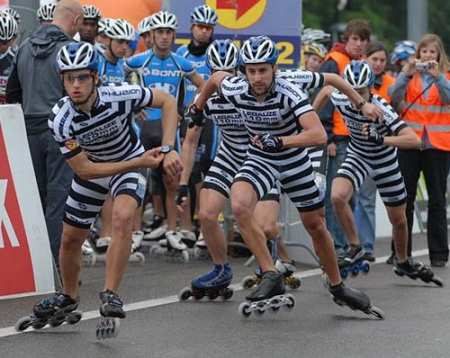 When Powerslide equipped its skaters with 110 mm wheels, everybody thought « It’s too hard to launch, it’s too dangerous for the ankles… » And yet, when looking back the transition happened, at least for the elite packs, both men and women.
When Powerslide equipped its skaters with 110 mm wheels, everybody thought « It’s too hard to launch, it’s too dangerous for the ankles… » And yet, when looking back the transition happened, at least for the elite packs, both men and women.
For about a year, some skaters such as Yann Guyader used a 3×110 mm / 1×100 mm set-up before finally upgrading to 4×110 mm.
In the women’s, the shift from 80 mm to 84 mm, then to 100 mm and last but not least to 110 mm took more time: with more weight on smaller body builds, a bigger period of adaptation was needed. The South-American and Asian female skaters, stronger, were the first to have a go at 3×110 mm / 1×100 mm then at 4×110 mm. Today at the world championships 4×110 mm has become the rule!
Slimmer and lighter skaters, less powerful, such as long distance skaters, needed more time to adapt, just as the men evolving in the middle of the pack where 3×110 mm / 1×100 mm set-ups still have quite a lot of success.
The 125 mm shows up in 2014
Like each time, we think we have reached the limit with the 110 mm. Yet we already know that a model of long distance fitness skates will be available on the 2014 Powerslide catalog. Cadomotus seems to want to release a model with that diameter too.
The diameter is rare but has been existing since 2003. In 2007, Bont released a design of frame equipped with 3 wheels of 120 and 125 mm. At the same period Toxin Wheels with the Revotech and Maxxon Sports also designed 3×125 mm frames. Those brands have disappeared since then.
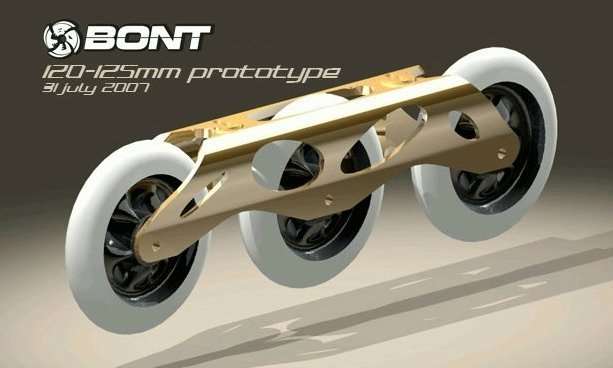 That set-up seems to have been used indoors in the USA for several years already. Some tests have also been carried out at the World Championships of Speed Skating in Oostende as well as at the Marathons of Duluth (USA) and Berlin (Germany). Powerslide has serious assets to bring to the table. The German brand already produces big diameter wheels for Nordic Skating. Moreover, it is close to American firm Matter.
That set-up seems to have been used indoors in the USA for several years already. Some tests have also been carried out at the World Championships of Speed Skating in Oostende as well as at the Marathons of Duluth (USA) and Berlin (Germany). Powerslide has serious assets to bring to the table. The German brand already produces big diameter wheels for Nordic Skating. Moreover, it is close to American firm Matter.
Brands have already started to negotiate with the FIRS to legalize the 125 mm. The maximum wheel diameter is currently of 110 mm with a maximum frame length (wheels included) of 50 cm.
Then what equipment to use?
It all depends on your built, your practice and your goals.
For leisure use, the most important is to be at ease in your skates, the diameter doesn’t matter much. Small wheels suit better the urban practice where you need to constantly slow down and accelerate. Big wheels swallow up the miles more easily.
For long distance skating, a big diameter will bring you enjoyable comfort. You don’t need to go up to the 4×110 mm, especially if you want to save money or if you have to face various reliefs. For trek practice, you may think about set-ups such as 4×100 mm or 3×110 mm, even 3×110 mm / 1 x 100 mm according to your form of the day. It would be interesting to test a 3×125 mm set-up as it would be completed with high-cut boots, which should not be the case in speed skating.
In speed skating: It is hard not to go for big diameter. Women will go towards 3×110 mm / 1×100 mm or towards 4×110 mm if they are high level athletes. It implies a lot of technical work and power.
For men, the 4×110 mm set-up has become compulsory at the international level. However, smaller and/or thinner body types will get by fine with 3×110 mm / 1×100 mm if the route implies changes of speed. It would be interesting to analyze the influence of big diameters on the unfolding of races…
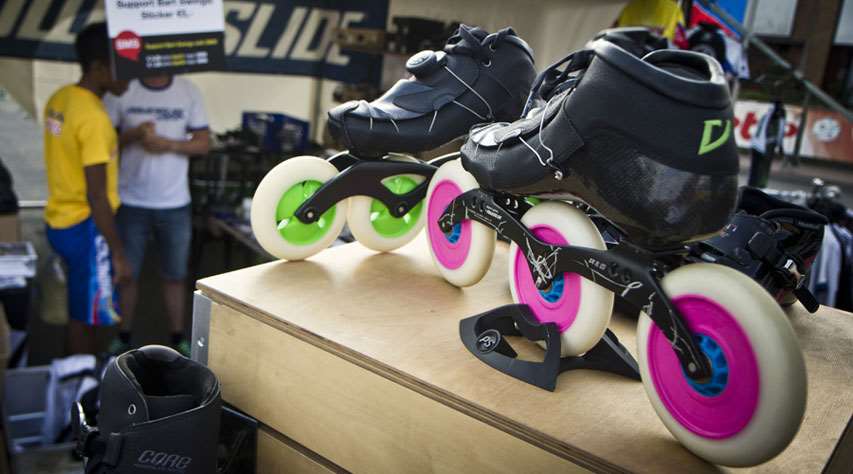
Summary table of weight variations according to diameters
|
Setup |
Total wheels weight* |
% of wheel weight variation |
pair of frames weight |
% of frames variation |
total wheels+frames weight |
% of total weight variation |
|
5×80 mm |
600 gr. |
– |
430 gr. |
– |
1030 gr. |
– |
|
5×84 mm |
780 gr. |
+30% |
442 gr. |
+2,8% |
1222 gr. |
+18,6% |
|
5×88 mm |
880 gr. |
+46% |
448 gr. |
+4,2% |
1328 gr. |
+28,9% |
|
5×90 mm |
900 gr. |
+50% |
450 gr. |
+4,6% |
1350 gr. |
+31,1% |
|
4×100 mm |
899 gr. |
+50% |
444 gr. |
+3,2% |
1343 gr. |
+30,4% |
| 4×110 mm | 1184 gr. | +97,3% | 430 gr. | – | 1614 gr. | +56,7% |
| 3×125 mm ? | 1092 gr. | +82% | 430 gr. ? | – | 1522 gr. | +47,8% |
* The wheel weights may vary according to brands and models. We have worked out an average on several wheels for the different sizes in order to smooth out the differences. The variation percentages of the products’ weights are based on the 5×80 mm set-up.
Let’s note that as for the wheel weight, 5×90 mm and 4×100 mm are very close. The most consequent transition made as for the variation of total wheel weight was the shift to 5×80 mm to 5×84 mm.
Let’s also note that according to the table, a 110 mm set-up remains heavier than any other set-up, even if there is one wheel less that on the others. Is the gain of rolling or speed enough to compensate for the weight variation?
Photo gallery
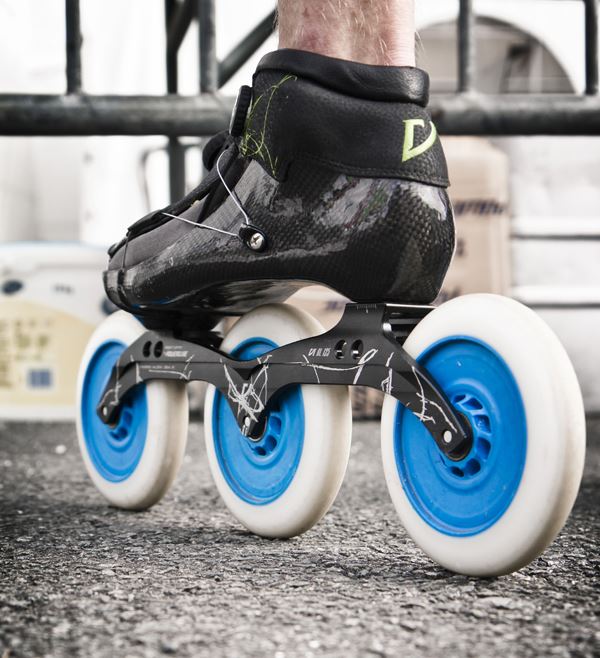 |
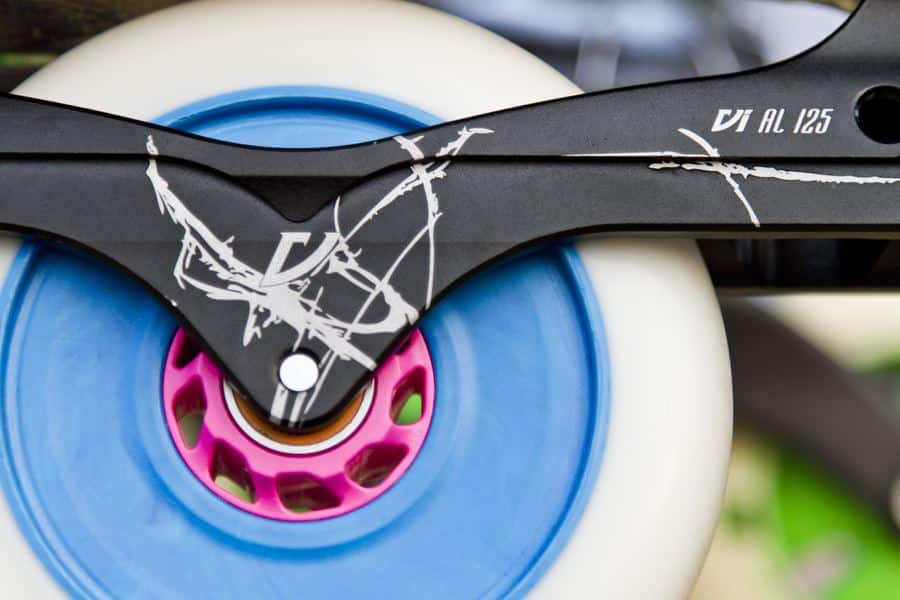 |
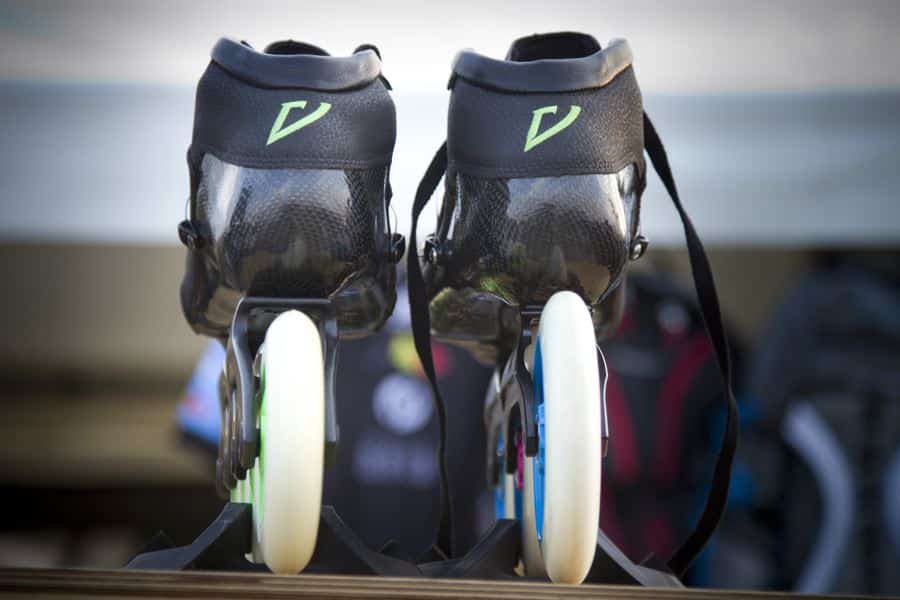 |
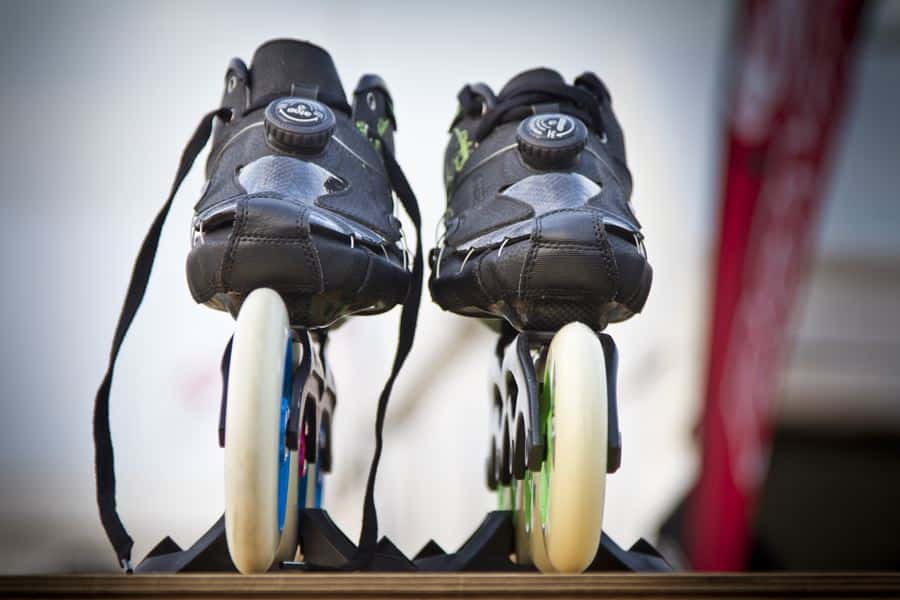 |
 |
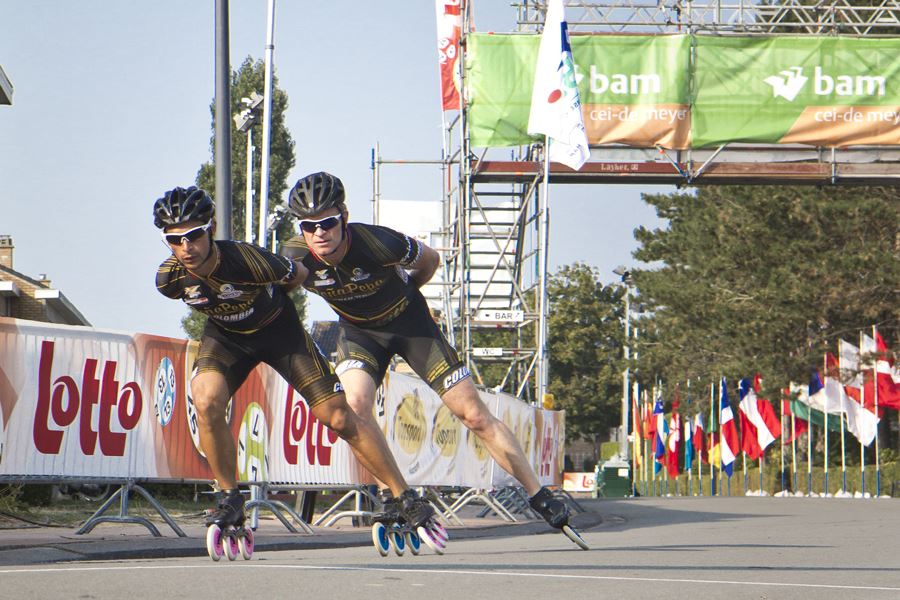 |
Video : interview with Christophe Audoire (english version soon!)
Links
Anatomy of an inline skate wheel
How are made skate wheels?
Inverting and looking after your inline skate wheels
3×125 mm: a new generation ? (by Cadomotus)
Translation: Chloé Seyres
Photos: Pathé, Salomon, Fila, Bont, Rollerenligne.com, Powerslide






Dafan
17 décembre 2014 at 1 h 44 min3x125
16 octobre 2013 at 5 h 32 min